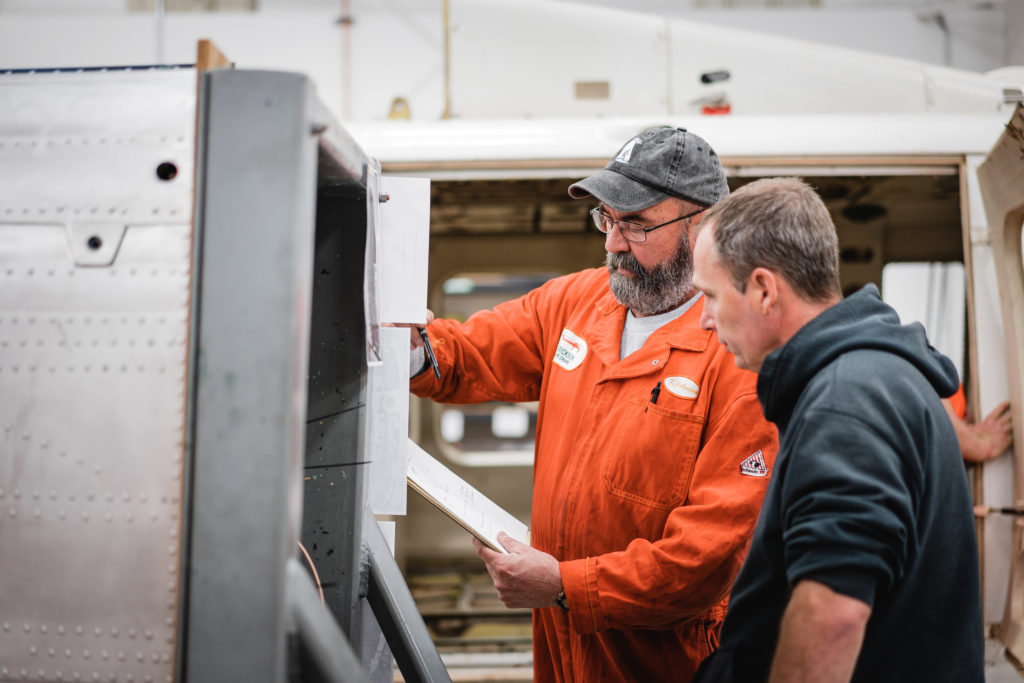Safety is a primary priority at Erickson Inc. The depth and reach of the safety program is broad.
By Jennifer Ferrero
Erickson Incorporated values safety above all else. It seems logical, as the company has pilots in the sky, mechanics in hangars, logistics managers planning firefighting strategies, and more. The company is in the business of saving lives and property along with safely setting up infrastructure on civil projects.
Yes, safety makes sense.

But the Senior Manager of People and Safety, Alexandra Fauver will tell you that safety is much more than a philosophy, it’s a way of life at Erickson. Prevention of workplace hazards is key.
There are four main areas of the workplace safety program for the organization:
- Occupational safety
- Aviation safety
- Environmental safety
- Emergency response
Fauver said that each of these key areas is inherent to ensuring that Erickson is, “Protecting our people, ensuring that when they are working, by following procedures, they will go home safely without long term issues and in good health. She said that whether an employee is deployed in Greece or Australia for fire season, working on a VERTREP project, providing MEDEVAC support for a customer overseas, or working in an office in Portland, Oregon, safety is key.
Along with a desire to nurture employees, Fauver ensures that all applicable laws and regulations are followed per Occupational Safety and Health Administration (OSHA), the Federal Aviation Administration (FAA), and Department of Transportation (DOT), within the working environment. She adds, “this is true for all branches, and employees will have the tools, training, and a safe environment in which to work.”
Nationally, safety is important to many organizations. The National Safety Council even dedicates a month to recognizing safety (June) by recognizing incident prevention, COVID safety concerns, feeling safe on the job, and continual improvement of safety in organizations.
At Erickson, the goal of continuously improving safety practices is company-wide and includes every employee. Fauver said that safety is actively represented through committee engagement, ongoing training, and on-site materials containing lists of all chemicals (SDS) used in every location as an example.
This is a big job because there are regulations to follow, and they change frequently. Then there is attention that must be paid to occupational safety – which concerns injuries, incidents, hazards, and OSHA compliance. This could be anything from someone stapling their finger to a piece of manufacturing equipment falling on someone.
Erickson maintains first aid kits, AEDs, bloodborne pathogen kits, skill kits, eyewash stations, and fire extinguishers. Employees are required to participate in checking on and maintaining this equipment so that it works when needed and they have the knowledge of where they are located and proper usage per type of fire. They also have personal protective equipment and follow safety and health standards.

Within aviation safety, a big-ticket item is being aware of and mitigating Foreign Object Debris (FOD). This can be something as simple as a pen falling into an aircraft vent that is dislodged during flight, causing something to jam or malfunction. FOD is serious business in this industry to the extent that Fauver said, they do full daily checks of each aircraft to ensure that nothing has been left behind on the aircraft. They double-check that all tools are safely in the tool crib at the end of each day and all personal tools are checked as well. Another significant item in aviation safety is maintenance manuals and logs. There are strict procedures and checklists in safety training to ensure that all measurement and instrumentation, pre and post-flight are documented. Fauver said that risk is reduced when all processes and procedures are followed.
With employees safe while doing their jobs – whether in an office, a home office, or out working somewhere in the world, Erickson also pays attention to environmental safety. This affects the public, employees, customers, and the environment. In a manufacturing environment, particulates, for example, from painting projects or other aerosol-based products must be managed. PPE has been important in this application long before the pandemic. Watching what people get on their skin, spill on the ground, inhale, or spray into the air is all strictly managed.
Lastly, emergency response is a large part of Erickson’s safety plan. There are Emergency Response Plans (ERPs) for many things from natural disasters to external attacks, pandemics, and more. Really anything that could require an emergency response must be planned out and documented so that any/all employees know how to respond.
Emergency response can include customers in the United States and on foreign lands and the plans are specific to the location in the world.
Fauver also said that being involved in safety-related trade groups and organizations is important for understanding trends and in making connections about safety with others in these roles. She is involved with the American Society of Safety Professionals (ASSP) and other groups. She also regularly reviews FAA and OSHA communications to be initiative-taking about changes.
Erickson Incorporated is focused on safety in several key areas. Ultimately, in the aerospace industry and in an international company with employees working worldwide, there is nothing more key to the business operations than keeping employees, customers, the public, the environment, and property safe.
To learn more about Erickson’s dedication to a safe workplace, visit www.ericksoninc.com/about or email us directly at safety_department@ericksoninc.com.

